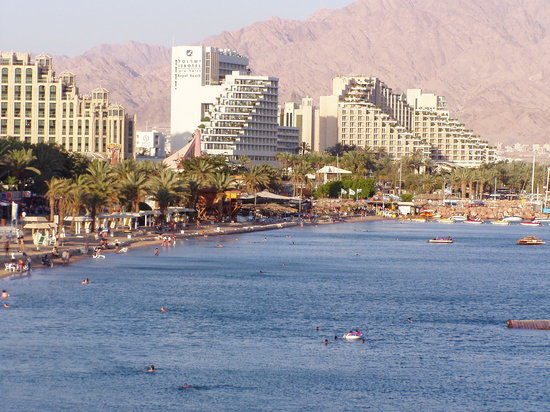
Driving into Timna Park, a 15,000-acre nature reserve expanse bounded by majestic, red-tinged craggy hills, it’s easy to feel the awe and serenity that’s the hallmark of any desert experience. Drive 20 minutes south, and you’ll arrive at the brash Red Sea resort town of Eilat, where water sports and shopping are the order of the day.
Timna is less than 10 minutes by car from the new Ilan and Assaf Ramon Airport that’s scheduled to open next spring near Eilat, in what is expected to be a game-changer for southern Israel’s tourism scene.
RyanAir, Monarch, Finnair, SAS and Wizz are among the airlines signed up to use the new airport, whose tower, runways and terminals lie in the Arava Valley, in sight of the scenic Edom Mountains.
Variety is the name of the game today for tourism development in Israel’s south. Tourism officials are predicting the opening of the ultra-modern Ramon Airport in 2018 will bring tens of thousands of visitors not just to Eilat, but to places like Timna and the varied desert attractions in the area.
Once Ramon Airport opens, southern Israel’s existing Eilat and Ovda airports will be closed, and at full capacity, Ramon Airport will be able to accommodate up to 2 million passengers per year.
Iris Danieli, the Israeli Tourism Ministry’s tourism manager for the Arava region and a member of Kibbutz Yotvata, is hoping that many of the tourists arriving on the expected 50 weekly flights arriving from Europe, the U.K. and several destinations in Eastern Europe will take the opportunity to discover places like Timna Park as well as some of the many other destinations and activities in the area.
“The Arava Valley is an incredible place to see a unique eco-system, bike and hike through terrain that’s historic and beautiful, and meet the special kind of people who choose to live in the desert,” Danieli says.
Halfway between Eilat and Mitzpe Ramon on Route 40 lies Kibbutz Neot Semadar, where inquisitive tourists will find inside the ornate white gates a lush oasis and tranquil guest houses, along with an innovative arts center, a boutique winery, a goat farm and hiking trails. It’s not your typical kibbutz, but the 200 people who live there are eager to welcome visitors to sample their lifestyle and their products, all based on ecological principles. There’s an opportunity to work in the vegetable garden, package spices or weave for those staying for a few days or longer in the simple accommodations, as well as a 1.5-hour tour if you’re just passing through the area.
For most of the year, the desert climate is perfect for biking and hiking explorations, and the infrastructure in the Arava and the Negev is sophisticated. Rental bikes are available at Timna Park as well as at Kibbutz Ketura and Kibbutz Yahel, which are both on Israel’s national bike trail and offer overnight accommodation, providing the chance to get a taste of kibbutz life.
Cycling enthusiasts praise the 185-mile southern segment of the bike trail that links Eilat with Mitzpe Ramon, and is designed for intermediate-level bikers looking for varied scenery. Serious hikers can set out from just south of Eilat on portions of the well-marked Israel National Trail, or tackle the Eilat Mountains Nature Reserve—the rockiest park in Israel, where on a clear day, you can see into Egypt, Jordan and Saudi Arabia.
The cozy Ibex Hotel in Mitzpe Ramon is owned by a biking couple, and caters to the growing number of bikers who descend on the area during the winter season, when the climate isn’t conducive to biking in Europe and many parts of North America.
“It’s you and nature out here,” says Ibex Hotel owner Aviva Schreiber, describing the environment in the town on the edge of Israel’s largest crater. Schreiber and her husband, Moshe, are trying to create an “après-ski” type of atmosphere for the bikers who gather at their venue. Located nearby are a couple of pubs and an upscale French restaurant where Israelis taking weekend trips mingle with Europeans and Scandinavians who have discovered the Israeli desert.
Financial incentives offered by the Israeli government to tour operators, and the 2013 Open Skies agreement that deregulated air traffic between Israel and Europe, account for the recent rise in the number of tourists to Eilat. Several low-cost airlines looking for new Middle East “sun and sand” destinations following unrest in Egypt’s Sinai Peninsula were enticed to fly their customers to Eilat, contributing to the more than 77,000 passengers arriving during the 2016 winter season. Shabtai Shai, head of the Eilat Hotel Association, is confident 250,000 tourists will fly in during the upcoming 2017-2018 winter season.
Currently, most American visitors arrive in Eilat through a 35-minute internal Israeli flight from Ben Gurion Airport, or by bus from the center of the country. Following a 10-percent increase in visitors from the U.S. to Eilat during the past two years, Uri Sharon, director of Israel’s Government Tourist Office in Germany, expects the Israeli Tourism Ministry’s marketing efforts to highlight “unique, unexpected, ‘wow factor’” sites in order to attract even more Americans to the area in the coming year.
(JNS)
{Matzav}











